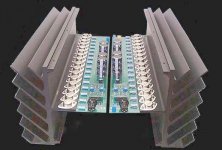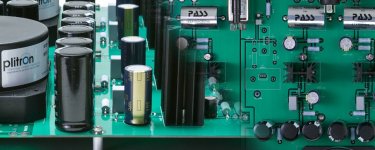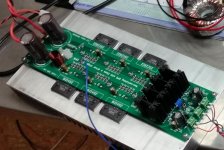Hi, can either metal oxide or metal film resistors be used in place of wirewound resistors as emitter resistors in a BJT output stage?
Wire wound resistors are more rugged. Metal film or metal oxide types will open circuit more readily due to overloads. This could put a high DC voltage on the speaker.
Hi JMFahey,
Actually, I've seen plenty of amplifiers where the inductance of the emitter resistor made the difference between oscillation and stability. Even in my own prototypes, this can make a difference. I was used to designing with the flat Japanese "plate" resistors.
-Chris
Actually, I've seen plenty of amplifiers where the inductance of the emitter resistor made the difference between oscillation and stability. Even in my own prototypes, this can make a difference. I was used to designing with the flat Japanese "plate" resistors.
-Chris
It's a question of available power ratings as much as specific amplifier designs where stability is doubtful. There are plenty of low-medium power commercial amplifiers (Naim Audio comes to mind) where standard 2-3W metal film resistors are used, sometimes interchangeably with single layer, wire wound types.
Some designs even use multiple parallel resistors but current sharing during fault conditions needs to be considered carefully. Close-wound wire will usually withstand overloads longer than film types but "Z folded" flat metal ribbon, as used in the Japanese low inductance "cement" resistors, is variable. Original types are usually robust but more recent copies seem to burn out fast during overload, probably because they are unsealed and have little but air to conduct heat away from the wire.
Some designs even use multiple parallel resistors but current sharing during fault conditions needs to be considered carefully. Close-wound wire will usually withstand overloads longer than film types but "Z folded" flat metal ribbon, as used in the Japanese low inductance "cement" resistors, is variable. Original types are usually robust but more recent copies seem to burn out fast during overload, probably because they are unsealed and have little but air to conduct heat away from the wire.
Last edited:
Oh yeah! WW source resistors yet were known as a possible cause for oscillations in the original (four device) ELEKTOR Crescendo amplifier from December 1982. Some months later a workaround was published: A small capacitor between both source legs should solve the issue. The later Mini Crescendo and also the Gigant (close relationship to the Crescendo) provided five 1 ohm 1 watt carbon resistors in parallel instead of one 0.22 ohms 5 watt WW.Actually, I've seen plenty of amplifiers where the inductance of the emitter resistor made the difference between oscillation and stability. Even in my own prototypes, this can make a difference. I was used to designing with the flat Japanese "plate" resistors.
Best regards!
You can get them non inductive but 99% emitter resistors out there are wirewound for robustness and take no special precautions against inductance since it´usually way too low to matter anyway.
If the emitter resistor inductance is bad why put an inductor on the output of the amp ? In fact the speaker is pretty inductive too.
I have been building amps for 40 years and have yet to see an amp have compensation for emitter resistor inductance.
I have been designing amps for 10 years and have never compensated for emitter resistor inductance. In every case any oscillation found has been due to other factors.
NS OPS first prototype - I used SMD thick film 2512 1W resistors.
Five 1 Ohm resistors in parallel gave me 0.2 Ohm 5W equivalent.
That worked very well. The main disadvantage - in case you need to replace them. A single wire-wound resistor in much easier to handle
Cheers,
Valery
Five 1 Ohm resistors in parallel gave me 0.2 Ohm 5W equivalent.
That worked very well. The main disadvantage - in case you need to replace them. A single wire-wound resistor in much easier to handle
Cheers,
Valery
Attachments
Inductance between output device and feedback take-off point is completely different to inductance between that and the load, they modify the compensation response in different ways.If the emitter resistor inductance is bad why put an inductor on the output of the amp ? In fact the speaker is pretty inductive too.
Fortunately sub-ohm WW resistors are not many turns and not very inductive anyway.
Some are; most are not.nigelwright7557 said:Wire wound resistors are wound back on themselves to cancel out any inductance.
Different circuit position, so potentially different result.If the emitter resistor inductance is bad why put an inductor on the output of the amp ? In fact the speaker is pretty inductive too.
Thanks for all the replies, much appreciated. There seems to be very mixed views on which type to use. I require 16 resistors for a 4 pair per channel class A amplifier, non inductive are quite expensive, 5W wirewound or 3 W oxide ( use two in parallel) are much cheaper. So I presume either of the latter two will be fine to use.
Regards
Alan
Regards
Alan
In the ouput stage of one of the first amps I first built. I substituted 5W ceramic wirewound emitter resistors with 4 x 1W Carbon Film resistors of appropriate value.
This amp had 'something' really good sounding about it and from later experiments with resistor chemistry/types I am quite sure this unusually good sound had much to do with the carbon resistors.
This is a cheap experiment to try and could be a way of 'voicing' your amp.
Dan.
This amp had 'something' really good sounding about it and from later experiments with resistor chemistry/types I am quite sure this unusually good sound had much to do with the carbon resistors.
This is a cheap experiment to try and could be a way of 'voicing' your amp.
Dan.
This is a cheap experiment to try and could be a way of 'voicing' your amp.
Where's the DBT to prove the outcome?
Best regards!
That amp did a million parties and everybody had a great time and nobody could see the resistors, is that what you mean ?.  .
.
I am serious though, OPS emitter resistor types are mission critical and IME can have strong influence of amplifier 'character'.
Wayne just gave away the family super secret special sacred sauce recipe, those blue Panasonic metal oxide film resistors are used extensively in Pass Labs gear.


Dan.
I am serious though, OPS emitter resistor types are mission critical and IME can have strong influence of amplifier 'character'.
Wayne just gave away the family super secret special sacred sauce recipe, those blue Panasonic metal oxide film resistors are used extensively in Pass Labs gear.


Dan.
Hello Valery.NS OPS first prototype - I used SMD thick film 2512 1W resistors.
Five 1 Ohm resistors in parallel gave me 0.2 Ohm 5W equivalent.
That worked very well. The main disadvantage - in case you need to replace them. A single wire-wound resistor in much easier to handle
Thin film resistors are much better tempco, linearity and noise than thick film - Thick film and thin film resistors
Vishay Selection Guide shows different chemistries of resistive element and passivation layer.
Cheers, Dan.
Hi JMFahey,
Actually, I've seen plenty of amplifiers where the inductance of the emitter resistor made the difference between oscillation and stability. Even in my own prototypes, this can make a difference. I was used to designing with the flat Japanese "plate" resistors.
-Chris
Well, maybe so in some cases, but I find such "sensitive/on the edge" designs too close to the precipice edge for comfort.
*Maybe* you were trying to make some extended range or ultra low distortion or whatever amp, kudos for that, but that may be risky.
Personally I feel more comfortable working with more conventional and stable designs, even if they don´t make headlines
And big problem often is: an "on the edge" design may be tweaked in a Lab environment ... but then end users are the unpredictable factor, they may use crazy impedance speakers, wild "exotic" cables, route cables in a wild way ... I remember one guy who was driving one local Hi Fi shop crazy ... until one employee personally checked his setup: he had bought some 30 meters long speaker cable "in case he might need it"
I would have loved to run an impedance test on that wire ball
Almost forgot: problem was solved the instant that mess was replaced by relatively straight speaker cables of the proper length, no knots involved.
- Home
- Amplifiers
- Solid State
- Output stage emitter resistors
